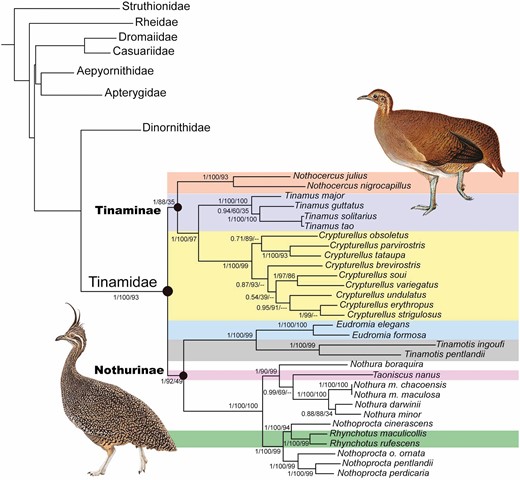Peter Kovalik
Well-known member




Thomas Valqui, 2009. Phylogeog[r]aphy of Nothoprocta tinamous and the phylogeny of the Tinamidae. PhD dissertation, Louisiana State University.
[Abstract]
Distribution of Nothoprocta ornata
...Some isolated predicted areas are of interest. To the north the largest terminal patch is partially occupied by the undescribed subspecies. It seems to be somewhat isolated by gaps in the predicted suitable habitat, but not completely so. Some of these areas were visited to see where the break or transition area was, but in areas of seemingly appropriate habitat, either no Nothoprocta was found or the species found was N. curvirostris. As seen on fig. 12 and 13, the new subspecies is isolated from branickii by poor or patchy habitat used by N. curvirostris. Also noted in fieldwork was that predicted patches for N. ornata to the north of dpto. La Libertad in dpto. Cajamarca were occupied by N. curvirostris, another example of possible interspecific competition...

Thanks for the info Peter.
Mentioned in the abstract for the same paper is the "paraphyly of Nothoprocta pentlandii, which requires that the northern populations (Nothoprocta oustaleti) be elevated to species rank".
Do you have any insight? Which form(s) are involved in the paraphyly and which subspecies (if any) would belong to N. oustaleti?
Thanks
My data produce a substantially different phylogeny (fig. 5) from any other proposed for Nothoprocta. The most divergent result is the paraphyly of Nothoprocta pentlandii. The clade composed of N. pentlandii (races pentlandii and patriciae, and allegedly doeringi and mendozae) with N. perdicaria, is sister to N. taczanowskii in every recovered tree with high (1.00) Bayesian posterior probability. The group of N. pentlandii oustaleti (with races fulvescens and allegedly ambigua and niethammeri) is not even basal to this group, and therefore needs to be considered a different species by any phylogenetic criterion. As seen in section 2.3.1., (table 2) this split is also supported by indels.






The evolution of tinamous (Palaeognathae: Tinamidae) in light of molecular and combined analyses
Abstract. The Neotropical tinamous are of particular interest in our efforts to understand the evolution of modern birds. They inhabit both forested and opacademic.oup.com
Need a new genus for :
'Nothoprocta' cinerascens
'Nothura' minor, maculosa, darwini

You read it ?Or, considering the age of many tinamou lineages and the small number of genera always used, cinerascens could be included in Rhynchotus and all Nothura except boraquira could be included in Taoniscus.
The recognition of two tinamou families would also be good - the two main group (forest/open country) are always shown to have separated around 40 million years ago.
I'll email youYou read it ?
I've just looked at the figures and not read the whole thing, but why not simply add Taoniscus to Nothura (thus keeping consistency between English and scientific names for most Nothuras) as well as as merging Rhynchotus into Nothoprocta?Or, considering the age of many tinamou lineages and the small number of genera always used, cinerascens could be included in Rhynchotus and all Nothura except boraquira could be included in Taoniscus.
The recognition of two tinamou families would also be good - the two main group (forest/open country) are always shown to have separated around 40 million years ago.

It would not be consistent with the old age of the clades. Generally, the average divergence time is 10 mya. Here, we far exceed 25 mya !I've just looked at the figures and not read the whole thing, but why not simply add Taoniscus to Nothura (thus keeping consistency between English and scientific names for most Nothuras) as well as as merging Rhynchotus into Nothoprocta?
That would be merging Nothoprocta (1873) into Rhynchotus (1825).as well as as merging Rhynchotus into Nothoprocta?
Would be fine by me. Or just merge N. cinerascens into Rhynchotus. Sounds more sensible to me, than to create a new genus for that one species.That would be merging Nothoprocta (1873) into Rhynchotus (1825).

In my opinion, they will choose the option of the new genus because the species is quite differentIn that case merge N. cinerascens into Rhynchotus. Sounds more sensible to me, than to create a new genus for that one species.

